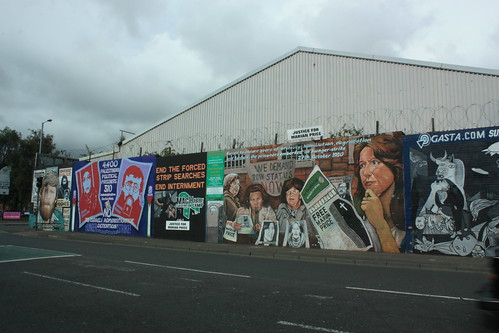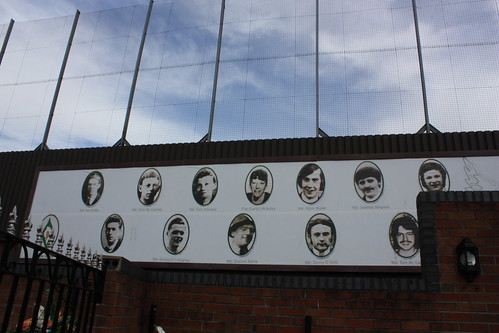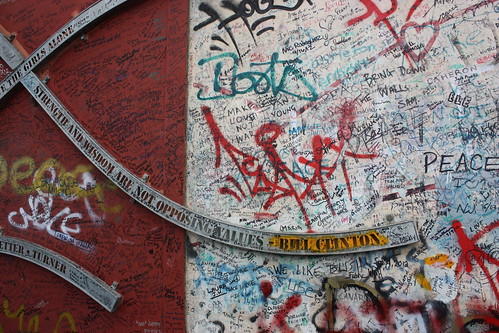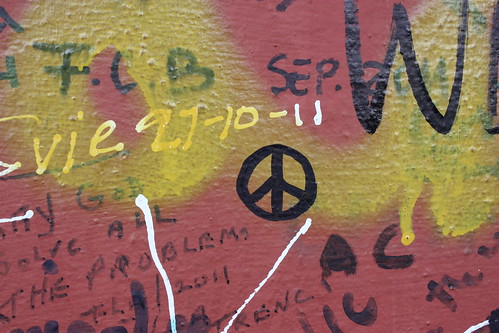WTF Weds: The Belfast Peace Walls

The Peace walls of Belfast, viewed from a Catholic neighborhood.
–
Usually, my WTF Wednesdays are not serious. They have to do with the many odd things I’ve encountered while traveling: inscrutable showers, another passenger’s toes in my personal space, more inscrutable showers … you know, the usual things that make my forehead wrinkle in confusion, then laugh.
This was not the case with the Peace Wall in Belfast. I saw no humor in it. I just stood, slack-jawed, trying to figure out what the hell was going on.
When I first heard the name, I figured it was the wall of some forgotten building in Belfast, usurped by idealistic do-gooders who were in possession of some paint, a few spare hours, and a modicum of artistic talent. Or perhaps some government-funded piece of public art that popped up after the Good Friday Agreement; something that would help usher in an era of understanding and respect between Nationalists and Unionists in Northern Ireland.
I was a little off.
Okay, fine, I was way off.
The Peace Wall – or should I say walls, since there are many of them? – has been in place since the late 1960s, when the Troubles first began. They were intended as temporary structures, but were later made permanent. They run all through Belfast, covering more than 13 miles of the city. The tallest stand more than 40 feet high, and many are lined with barbed wire at top; they looked like massive military barricades. Some have been decorated with murals, but many parts of the wall remain rather unsightly.

–

Portion of the Peace wall, featuring a memorial to some of those killed during the Troubles.
–
And here’s the clincher. Do you know why the Peace Walls exists?
Are you sitting down? If not, then sit down (trust me on this one; I was sitting when I first learned about them, in the back of a car, driving towards Belfast. I am thankful for that).
The Peace Walls separate the Protestant and Catholic neighborhoods of Belfast. In the event of a riot or a bombing, the few gates within the wall are designed to close, ostensibly to protect the people who live nearby.

Some of the gates in the wall. The lights at the top start flashing when they are about to close.
–
Or, as someone else put it, so that the two neighborhoods don’t tear each other apart.
The gates are shut nightly; several are closed throughout the weekends as well.
I have trouble keeping my cultural biases out of this one (hence this post being a WTF Wednesday). I don’t mean to be judgmental; it’s just that as an American of my generation, the whole thing is kind of hard to fathom. I grew up believing – thanks to Berlin and Bob Vila – that walls should be taken down. (Incidentally, I am strongly opposed to the border wall between Mexico and the U.S. that continues to be discussed. Senator Ted Cruz of Texas actually won his election by advocating a bigger, longer wall than his opponent.)
I’m not the only American who’s stuck their nose in this issue; millions of dollars have been raised by the International Fund for Ireland (mostly by my fellow countrymen) to take down the walls. One Irish columnist wonders what planet we’re living on, that we think taking down the walls would be a good move. He notes that it’s a sad reality, but Belfast still needs the walls. And that we’re basically well-intentioned morons for thinking we know better. Which is kind of a fair assessment. (Hell, I might put “Well-intentioned moron” on my business cards, it’s such an apt phrase.)
After all, the Peace Walls were erected at the request of the people of Belfast. This was not something imposed upon them unfairly by the government; this was something that the community wanted. Those who live on the borders between the Catholic and Protestant neighborhoods note how much safer they feel with the barriers in place (70% of them want to the walls to remain up, though among the rest of Northern Ireland, the walls are much less popular).

Rand looks at a home along the Peace Wall. Notice that there is a cage around their back lawn. We were told this was to protect them from thrown bottles.
–
Incidentally, we found similar opinions among people we talked to. Some said that as awful as they seem to be in concept, the walls work. Others argued that the walls make it easy to dehumanize those on the other sides of them.
Indeed, it does keep the peace, in some sense, but it also keeps the neighborhoods segregated. Two-thirds of 18 to 25-year-olds in Belfast claim they’ve never had a meaningful conversation with anyone from the other community.
I think it’s probably hard to move beyond the issues if you can’t even talk to the other side. But it’s easy for me to be critical of the walls; I’ve never lived in a city shaken by bombs and attacks. My hometown isn’t even divided by politics, really. Seattle is populated by a bunch of left-leaning liberals.

This blurry photo was taken as we drove through the gates.
–
There is one rather famous part of the wall, dividing the Protestant Shankhill Road and the Catholic Falls Road. It is covered with graffitti and messages of hope. We had to pass through a gate to reach it, moving from the Catholic part of town into the Protestant.
Once there, our guide (we took a Black Cab tour – I will tell you all about it soon) took out markers and invited us to write something.

–

–
At first, I couldn’t think of anything, so I just drew a silly little peace sign.

–
And then, as I read quotes from Gandhi and the Dalai Lama, and message after message of hope, some words came to mind. Short, pithy, and as American as the movie whence they came.
“Be excellent to each other,” I wrote.
And then I stepped out of the falling rain and into our cab, to head back to the other side of the wall.









Leave a Comment